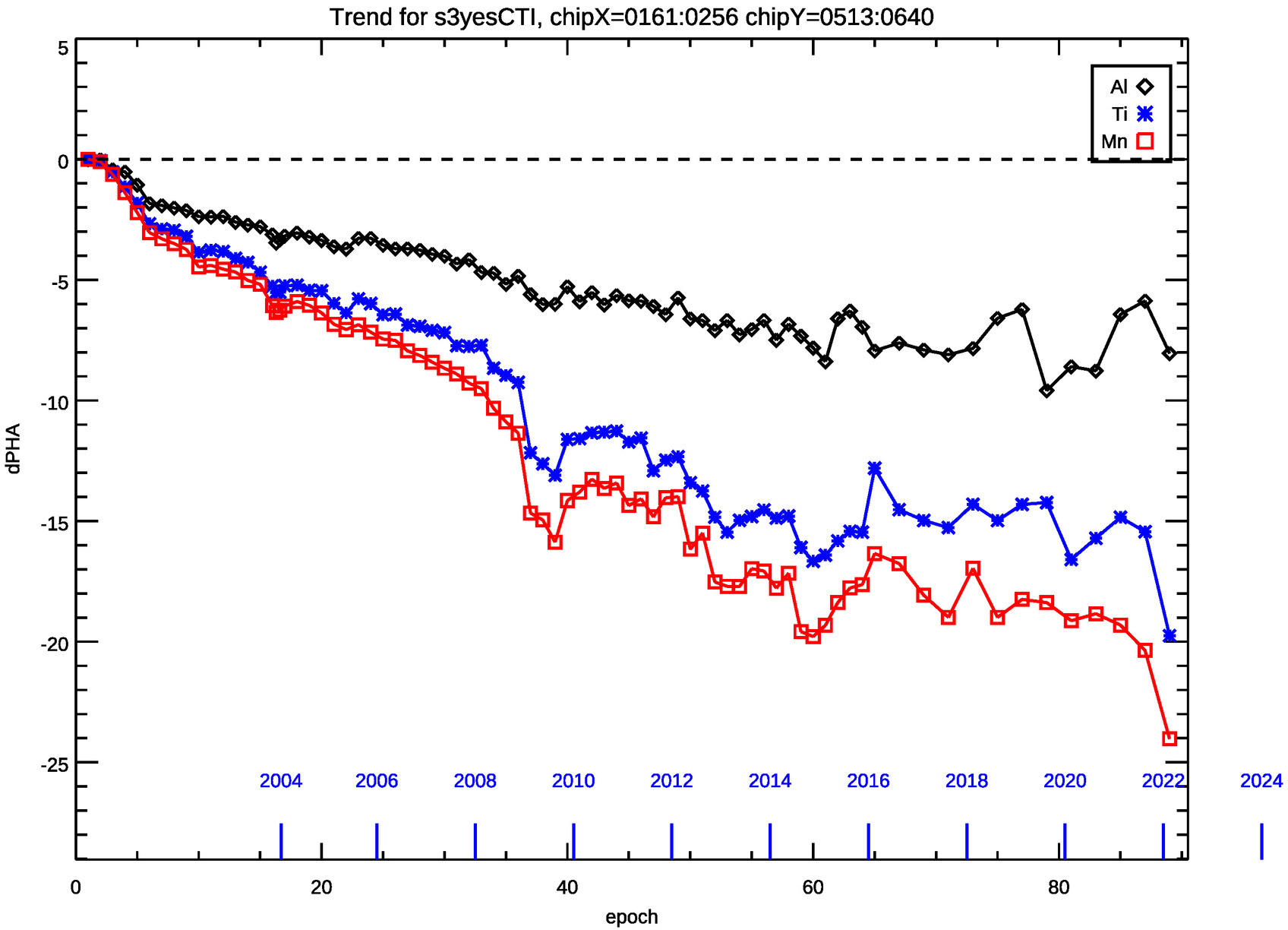CalDB 4.10.4 Public Release Notes
Public Release Date: 22 MAR 2023
SDP Installation Date: 2023-03-17T15:00:44 (UTC)
I. INTRODUCTION
CalDB 4.10.4 is an upgrade to the Chandra CalDB, which includes the following items:
For the CIAO 4.15.1 / CalDB 4.10.4 release notes see How CalDB 4.10.4 Affects Your Analysis.
II. SUMMARY OF CHANGES
A. ACIS T_GAIN Epochs 89-92 Updates
| Location: | $CALDB/data/chandra/acis/t_gain/ |
| Filenames: |
acisD2021-11-01t_gainN0002.fits 87-88 finalized GRADED acisD2021-11-01t_gainN0008B.fits 87-88 finalized non-GRADED acisD2022-08-02t_gainN0002.fits 89-92 provisional GRADED acisD2022-08-02t_gain_biN0002.fits 89-92 provisional non-GRADED |
The ACIS Calibration Team has generated time-dependent gain (T_GAIN) corrections from onboard External Calibration Source (ECS) data taken during the period of 01 February 2022 through 31 Jan 2023 (i.e., quarterly Epochs 89 through 92). With this release it is now possible to finalize the T_GAIN for the previous bi-epochal period (Epochs 87-88, Aug 2021 through Jan 2022). These updates are included in the files above with effecive dates 2021-11-01T00:00:00 (finalized) and 2022-08-02T12:00:00 (provisional) respectively. Beginning with this release, ACIS T_GAIN upgrades will be done annually going forward, rather than semi-annually.
This release affects all ACIS observations taken since 2021-11-01T00:00:00, and users of any OBS_IDs with DATE-OBS later than that date are encouraged to reprocess their datasets. The degree of the corrections is similar to those of previous T_GAIN releases, and those analyzing narrow line-source data are the most likely to be affected signficantly. See the Section III.A technical details section below for further information regarding these specific file upgrades.
See the ACIS Time-dependent Gain why page for a more basic explanation of the time-dependent gain correction.
PIPELINES/TOOLS AFFECTED:
ACIS Level 1 pipeline tool acis_process_events.
CIAO script chandra_repro uses acis_process_events to reprocess ACIS observation data.
THREADS AFFECTED:
Reprocessing Data to Create a New Level=2 Event File
B. PCAD DARK_CURR Updates #2
| Location: | $CALDB/data/chandra/pcad/dark_curr/ |
| Filenames: | acapD2022-08-26darkN0002.fits acapD2022-09-24darkN0002.fits acapD2022-10-11darkN0002.fits acapD2022-11-10darkN0002.fits acapD2022-12-20darkN0002.fits acapD2023-01-23darkN0002.fits |
Note: CIAO does not include the ASPECT pipelines, and hence is not affected by these updates.
The Aspect team has released six (6) new PCAD DARK_CURR files to add to the set of 121 files released with CalDB 4.10.0 (June 2022), and the five (5) additional file release with update set 1 (October 2022). These new files extend the date coverage for archival observations through 2023-01-23T00:00:00, with the final file being the one that will be effective in standard data processing (SDP) until the next periodic dark current updates.
We are expecting to update the dark current CALDB files periodically as more full field ACA dark current data products become available as part of regular CALDB updates. This release of five new DARK_CURR files is the second such periodic release.
The DARK_CURR files draw on an ever-growing database of ACA full field dark current data products which have been accumulated since the 1999:223 OAC dark current pixel map. Each version N0002 dark current fits file in the CALDB includes a 1024x1024 image with the processed full-field dark current map of the ACA CCD in e-/sec. Each file also includes header information with the ACA CCD temperature of the calibration, the reference date of the ACA dark current product, and the scale expected to be used to scale the calibration e-/sec to the effective e-/sec at the observed temperatures during observations.
PIPELINES/TOOLS AFFECTED:
SDP ASPECT Level 1 Pipeline tool asp_get_calib (not a CIAO tool).
THREADS AFFECTED:
None.
III. TECHNICAL DETAILS
A. ACIS T_GAIN Epochs 89-92 Updates
The general description and method of derivation for the ACIS T_GAIN are given in the memorandum posted on ACIS Calibrationweb page http://cxc.harvard.edu/cal/Acis/Cal_prods/tgain/index.html. However, additional steps have been added to the derivation procedure, due to the ever poorer statistics that are attainable from the ECS due to the source's diminishing flux levels. In particular, the ACIS calibration team has used trends from previous epochs (when more ECS flux was available) to "nudge" their more recent results to provide more predictable time-dependent gain corrections. The method is to combine earlier epochal data with current (i.e. new) epochal data to generate a 12-month average for T_GAIN corrections, and use the trends form the 12-month averages to modify the 6-month averages, resulting in a smoother correction with better statistical support.
The data are increasingly noisy as the ECS flux decreases with the age of the spacecraft. As a result the ACIS team is has selectively increased the range of acceptable operating focal plane temperatures (FP_TEMP values) for all of the 10 chips in order to include more events for better statistics in the T_GAIN correction values. This expanded range is 151.96K to 154.96K.
Long term trends for chips I3 and S3 are plotted below in Figures 1a and b, through Epoch 92, which includes the latest release. The chip locations for these plots are given in the respective labels above the plots. The chip locations selected are near the aimpoints. The full CTI corrections have been applied to the data in both figures. While some fluctuations have occurred recently in the results for the Ti and Mn lines of the ECS for I3 in particular, there is nothing out-of-expectation for the newest datasets. The fluctuations in the traces are due to counting statistics.

